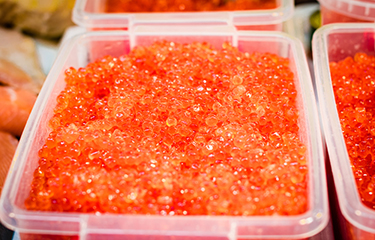Russia cracking down on illegal salmon roe harvests, smuggling

The Russian government has decided to take increased measures against illegal sales of salmon roe, which often involve fraudulent schemes. Authorities want more transparency throughout the product’s trade and financial flow, and more taxes paid to the state’s budget as a result.
Passenger luggage a key target
In 2018, Russian fisheries caught record volumes of salmon totaling 676,000 metric tons (MT). This year’s forecast is 460,000 MT, which is likely to be exceeded as the current result is nearly 50 percent more than the same period in 2017.
There is a downside to the good harvests. The issue of illegal salmon roe sales, which has been discussed for years in professional circles, has risen to public attention and appeared in headlines of the mass media due to the increased salmon harvest: More salmon means more salmon roe, which means more potential for illegal sales, bad quality, and lower prices.
Almost all the salmon catch in Russia is harvested in the Russian Far East, a very vast and sparsely populated area with just one person per square kilometer on average. Poor controls, coupled with corruption, enables residents to make money by harvesting salmon, packing salmon roe in various types of packages, and dispatching it to consumers in the central part of Russia by various means – including air travel and the Russian Post. These packages go as personal items either directly to end consumers or through intermediaries who then sell them in markets and shops.
Sergey Dankvert, head of the Russian Federal Service for Veterinary and Phytosanitary Surveillance, said in an interview with the Russian Newspaper that his service conducted research and revealed rather interesting data.
“Residents of the regions of Kamchatka, Magadan and Sakhalin dispatch salmon roe in great numbers,” he said. “Sixty metric tons of the product a week was dispatched through just one airport.”
In October 2018, toward the end of the salmon season that year, the common weight of luggage of air passengers leaving Kamchatka for the cities of Moscow, Novosibirsk, and Vladivostok “suddenly” increased by 49 percent when compared to October 2017.
The figure of 60 MT, given the number of dispatchers, reveals the fact that much of this volume is sourced illegally.
The Ribak Kamchatki (Fisherman of Kamchatka) newspaper added to Sergey Dankvert’s revelations. It reported that employees of a Russian Post branch in the Kamchatka region had filed a complaint to their supervisory bodies, saying they had to work too much as consumers were bringing too many heavy dispatches of 28-29 kilograms. These dispatchs contained salmon caviar, and caused a lot of labor and equipment deterioration.
There’s also plenty of ads in newspapers and announcements on social media from Kamchatka’s residents who are looking for someone flying from Kamchatka to Moscow – or another big city – and are ready to take additional luggage. For extra money, of course, the newspaper reported.
Strictly speaking, this “consumer-to-consumer” format doesn’t violate Russian law as there is no direct prohibition against sending salmon roe from person-to-person as personal property. Neither does there exist any restrictions on volume.
“Russian legislation doesn’t define which volume one person can send anywhere for his personal use,” Dankvert complained in the aforementioned interview.
But it is also obvious that salmon roe dispatched in tons from person to person is not a subject of property, but a subject of business relationships, relationships which don’t benefit the state’s budget or the issue of quality and compliance with safety standards.
The record catch caused one more problem: Black marketeers were followed by swindlers. The good harvest of salmon led to increase in supply of salmon and, as a consequence, a fall in prices for salmon roe. In late 2018, deputy head of the Russian Federal Agency for Fisheries Vasily Sokolov told in his conversation with journalists that nearly 20,000 MT of salmon roe had been produced in the country at the time of the interview, with the national market being able to consume only 12,000 to 14,000 MT. Even exports couldn’t help.
As a result, wholesale prices for the product fell by 40 percent, with retails prices almost repeating this path. Overall, in 2018 up to 30,000 MT of salmon roe was harvested in Russia, the Fishery Agency calculated, twice as much as the domestic market needs.
The trend toward low prices was widely covered by media, and swindlers jumped on bandwagon starting to sell false salmon roe online. They attracted consumers by incredibly low prices claiming that the cheapness was caused by the great salmon season and sold imitated products instead of natural ones.
These trends urged the government to tackle the problem, which in previous years had not been a top priority. Amid the economic downturn Russia has been experiencing since 2014 getting more money for the state’s budget would be of help, and the salmon roe segment is an area where a great amount of reserves lay.
This story continues on page 2...
Photo courtesy of Shutterstock






Share